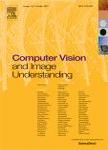版权所有:内蒙古大学图书馆 技术提供:维普资讯• 智图
内蒙古自治区呼和浩特市赛罕区大学西街235号 邮编: 010021

作者机构:Univ Milan Dept Comp Sci Via Bramante 65 I-26013 Crema CR Italy Michigan State Univ Dept Comp Sci & Engn E Lansing MI 48824 USA
出 版 物:《COMPUTER VISION AND IMAGE UNDERSTANDING》 (计算机视觉与图像理解)
年 卷 期:2019年第188卷
页 面:102787-000页
核心收录:
学科分类:0808[工学-电气工程] 08[工学] 0812[工学-计算机科学与技术(可授工学、理学学位)]
基 金:Italian Ministry of Research within PRIN [201548C5NT] National Science Foundation Division Of Computer and Network Systems Direct For Computer & Info Scie & Enginr Funding Source: National Science Foundation
主 题:Image resolution
摘 要:In this work, we propose a robust iris segmentation method for non-ideal ocular images, referred to as Polar Spline RANSAC, which approximates the iris shape as a closed curve with arbitrary degrees of freedom. The method is robust to several nonidealities, such as poor contrast, occlusions, gaze deviations, pupil dilation, motion blur, poor focus, frame interlacing, differences in image resolution, specular reflections, and shadows. Unlike most techniques in the literature, the proposed method obtains good performance in harsh conditions with different imaging wavelengths and datasets. We also investigate the role of different illumination compensation techniques on the iris segmentation process. The experiments showed that the proposed method results in higher or comparable accuracy with respect to other competing techniques presented in the literature for images acquired in non-ideal conditions. Furthermore, the proposed segmentation method is generalizable and can achieve competitive performance with different state-of-the-art feature extraction and matching techniques. In particular, in conjunction with a well-known recognition schema, it achieved Equal Error Rate of 4.34% on DB WVU, Equal Error Rate of 5.98% on DB QFIRE, and pixel-wise classification error rate of 0.0165 on DB UBIRIS v2. Moreover, experiments using different illumination compensation techniques demonstrate that algorithms based on the Retinex model offer improved segmentation and recognition accuracy, thereby highlighting the importance of adopting illumination models for processing non-ideal ocular images.